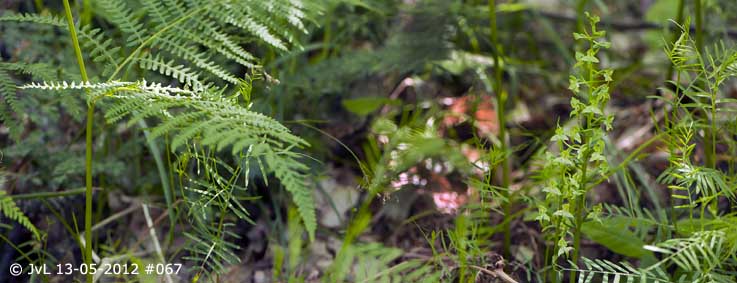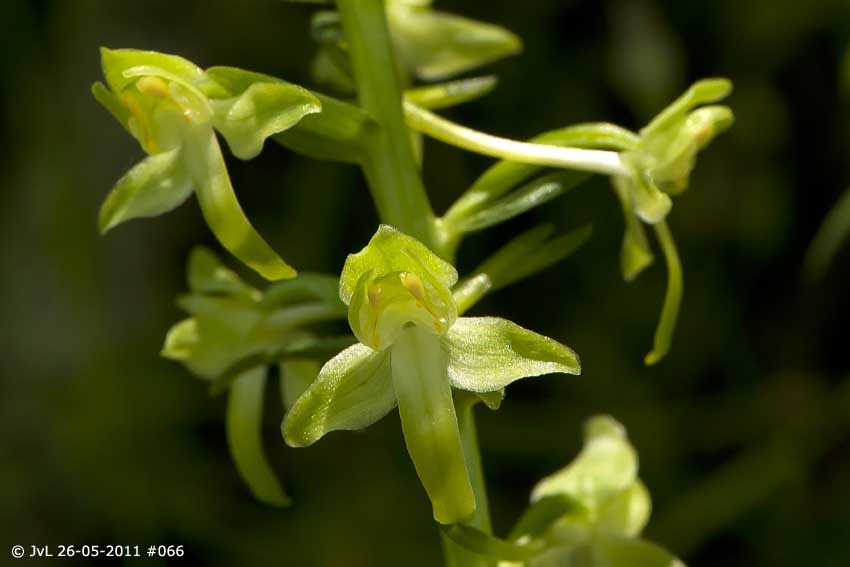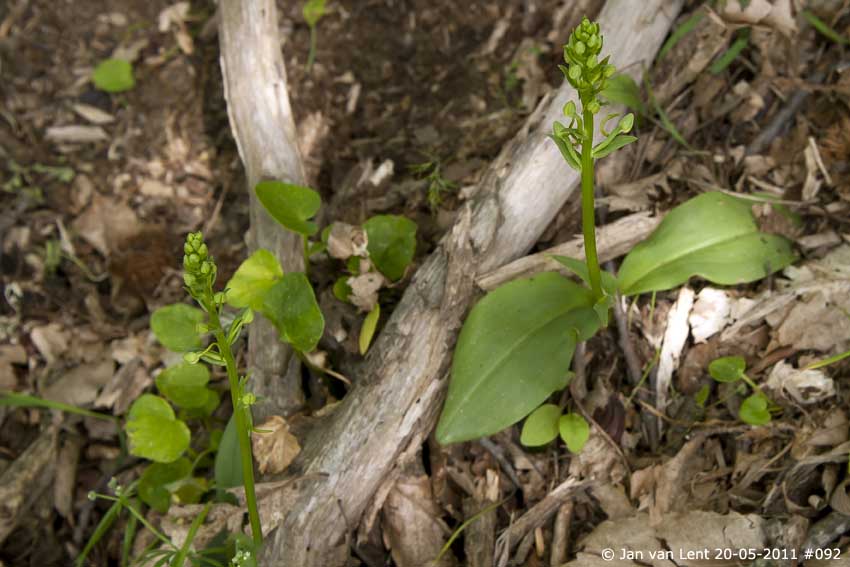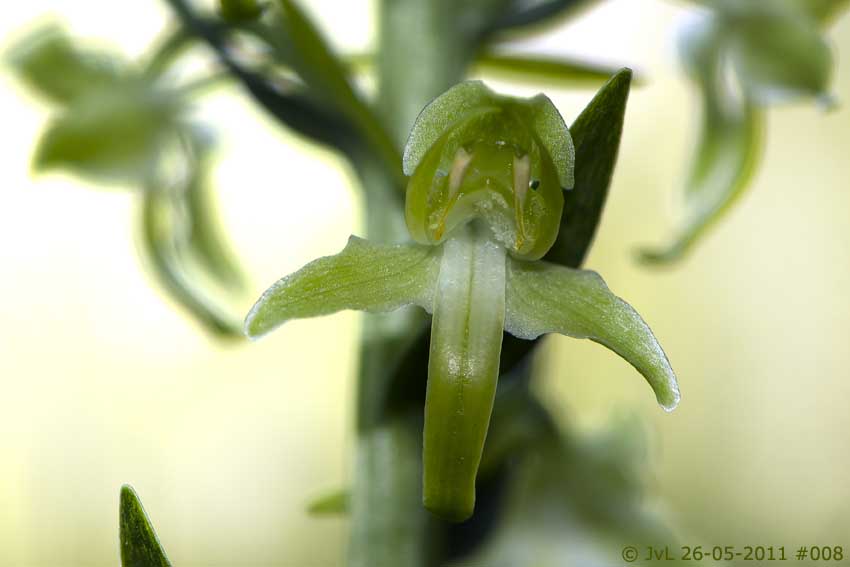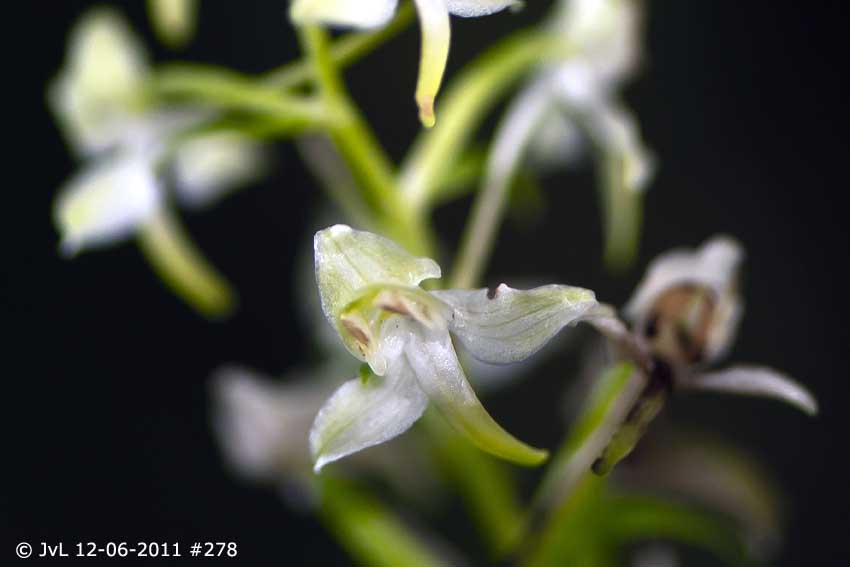Habitat: chestnut forest above Agiasos.
Platanthera holmboei, chestnut forest © JvL 13-05-2012 #067
Platanthera holmboei H.Lindberg fil. 1942. On Levos: only Platanthera holmboei?
HUNTING: Every late spring, in early summer and in the autumn I go out hunting in the beautiful Chestnut forest above Agiasos and Sanatorio. In autumn I hunt chestnuts there (other people shoot wild boar and deer then), and in April, May and June, I photograph orchids in those surprisingly cool woods here just under the Olympos mountain peak. But there are not a lot of orchids to hunt in this chestnut forest; many years I just came back with 4 Orchids: Orchis morio, provincialis & tridentata and Cephalanthera longifolia. Until, one hot day in the beginning of May last year, I parked my car in the shadow under a huge chestnut tree, stepped out and saw some Wild Peony (Paeonia mascula) shimmering between the trees high on the very steep hill in front of me. I went up to photograph them (yes, I’m not only doing orchids, peonies flower for just one week in the season, and I’m always fascinated by these big flowers), and climbed further up to the top of the hill (770m) to enjoy the view over the forest, the Olympos and Agiasos. Next to the field was an old stone wall, the barrier between the grassy field where the Peonies were growing and the chestnut forest. A piece of this wall was collapsed so I took a look in the forest, walked a few metres, stopped to let my eyes get used to the darkness, put my rucksack on the ground; almost on top of 2 small green Platanthera holmboei between the green ferns.
Platanthera holmboei, chestnut forest © JvL 26-05-2011 #066
Until that moment I had never found a Platanthera in the ‘wild’. I knew that they were growing in this chestnut forest (because Karatzá mentioned this in his book and Manning on his website) but I had never found them! Besides the darkness, there is here, high up in the mountains between 2 and 6 in the afternoon, no sound to be heard, except of course the rustling of the chestnut leaves. So my heart stood still (for a moment) when next to me a big tortoise was composedly walking up the hill, eating the flowers in front of him. I didn’t dare to move my feet anymore in fear of stepping on other Platanthera or on this tortoise and looked around. And I mean you really have to look very, very hard to see these small green Platanthera in this forest. But after a while I saw 4 more plants standing on the left of me, and two more a few metres uphill. But unfortunately not one of them was yet flowering, so I took my photographs and walked down. And of course I decided to come back next week.
Platanthera holmboei, chestnut forest © JvL 20-05-2011 #092
RESEARCH: But first let’s look which Platanthera is growing where: In 1980 SUNDERMANN followed SCHLECHTER (1928) who made 4 groups of Platanthera: bifolia (W- and E-Europe, N-Africa, N-Turkey, Russia, Greece – Asia up to the Himalaya and E-Siberia;
chlorantha (W- and E-Europe, N-Africa, Turkey, Russia, N-Greece – M- & E-Asia;
oligantha (N-Sweden, N-Finland, N-Russia, Siberia);
hyberborea (Island, Greenland, N-America);
micrantha/azorica (Azores). Do I count 5 groups? Yes I do!
This means that in principle there could be two Platanthera species growing on Lesvos(N-E-Greece): bifolia and chlorantha. The difference between bifolia and chlorantha is the position of the housings of the pollinia (the pollen bundle: the only two yellow parts of the flower): bifolia parallel and close to each other, chlorantha wider separated on the base and pollinia divergent (forming an open roof). So my Platanthera are certainly not P. bifolia. Under P. chlorantha Sundermann described two subspecies: ssp. chlorantha and ssp. algeriensis (Algeria and Morocco). But: ‘the difference (ssp. algeriensis) compared to chlorantha is insignificant, all the more because the distinguishing marks (green flowers, backwards curved lip, swollen spur and long bracts) also appear from time to time on chlorantha, or, for example on the from Cyprus described P. holmboei Lindberg 1942, which I place under chlorantha’.
So according to SUNDERMANN there was no P. holmboei, only P. chlorantha.
Let’s go to Turkey with KREUTZ (1998). He described three Platanthera species in Turkey: bifolia, chlorantha and holmboei. Platanthera holmboei: ‘Eastern Mediterranean, Lesbos,Turkey, Israel, Lebanon, W-Syria and Cyprus. For a long time it was thought that this species was endemic to Cyprus. Current reports submit Israel (KREUTZ 1993a), Cyprus (MORSCHEK 1996), Lesbos (BIEL 1998) and Turkey (KREUTZ 1998)’.
But this sentence confuses me still: ’Platanthera holmboei, in those days still Platanthera chlorantha, was found for the first time on Cyprus by KOTSCHY in 1859 (UNGER, et al., 1865). How’s that? Platanthera chlorantha was for the first time described in Switzerland by Reichenbach in 1827-28 I thought and Platanthera holmboei in Cyprus by H. Lindberg in 1942. So is there actually a difference between finding and describing, Kreutz?
KREUTZ, six years later (2004) in ‘The Orchids of Cyprus’ about Platanthera holmboei: ’Described from Cyprus by Lindberg in 1946 (?), this species has its main distribution area in the Troodos mountains and makes an abundant appearance in June, especially on the southern slopes. WOOD (1985) also reports P. chlorantha for Cyprus.
Kreutz: ‘There are indeed plants at the lower altitudes which are difficult to differentiate from P. chlorantha. There are plants at lower altitudes in Turkey, e.g. at Uludag near Bursa, which share characteristics both of P. chlorantha and also P. holmboei (KREUTZ 1998). All reports for the genus Platanthera have been placed in this book under P. holmboei, as the probably findings of P. chlorantha certainly involve lighter coloured specimens of P. holmboei. P. holmboei resembles P. chlorantha, but can be distinguished from this species by a lax inflorescence, by distinctly smaller light to dark green flowers and by the thread-like, not clubbed, horizontally directed spur.’
BAUMANN/KÜNKELE/LORENZ (2006): ‘P. holmboei is an east-Mediterranean plant: Lesbos, SW- & S-Turkey, Cyprus, NW-Syria, maybe Lebanon, N-Israel’. Difference between P. holmboei and chlorantha: ‘P. chlorantha grows higher, has bigger and lighter coloured flowers, spur is longer.’
Okay, so Lesvos is the only place or island in Greece where Platanthera is growing? Maybe, because TAYLOR (2012) didn’t find Plantanthera on Chios, KRETZSCHMAR & Eccarius (2004) didn’t find Platanthera on Crete & the Dodecanese, nor did KREUTZ (2002) on Rhodes and Karpathos.
And DELFORGE (Europe e.a 2005): ‘(P. holmboei) distribution: Eastern Mediterranean, reported from the coastal mountains from southern Anatolia south to Israel; may reach the Greek islands in the eastern Aegean. Rare and local.
’O, and for the spur: ’cylindrical, little or not at all flattened at tip.’ ‘(P. chlorantha) distribution Mediterranean: north to the coast of central Norway, south to Sicily. South-Eastern and south-Western limits poorly known as a result of confusion with neighbouring taxa. Widespread but uncommon.’
KARATZÁ (Lesvos 2008) found only Platanthera holmboei, and also between Agiasos and Megalochori.
Platanthera holmboei, chestnut forest © JvL 26-05-2011 #008
BOTTOM-LINE: And I came back to the Chestnut forest two more times in May: once on the 20th and again on the 26th of June. On that day we had to run for our lives because lightning suddenly struck around us. In those dark woods we hadn’t see the dark blue sky coming; the thunderstorm came very quickly over the top of the hill. Running (or almost falling) down I also had to jump high when I almost stepped on a poisonous Viper who was also sliding down to safety.
But I came back in June to see if there were maybe other interesting orchids around on this spot. And then I photographed this plant:
Platanthera chlorantha, chestnut forest © JvL 12-06-2011 #278
Is this still P. Holmboei? I don’t think so. I think this is Platanthera chlorantha (Custer) Reichenbach 1827. The difference between P. holmboei and P. chlorantha is, apart from the later flowering time of chlorantha (3 weeks later), the more whitish colour, the more lax inflorescence, the small tongue like lip which is weakly to strongly turned backwards and which gets smaller down to the lip point, and the thread-like (not clubbed) horizontally directed spur. Okay, the spur I don’t know, but the rest points in the direction of chlorantha. However, according to the experts there is no Platanthera chlorantha on Lesvos. Again I have to quote KREUTZ (2004) in ‘The Orchids of Cyprus’: ‘there are indeed -P. holmboei- plants at lower altitudes in Cyprus and Turkey which are difficult to differentiate from P. chlorantha but these are probably lighter coloured specimens of P. holmboei.’ Well, this habitat is not on a low altitude but on 770m, the first Platanthera flowering here on this habitat (8-5-2011, 20-5-2011, 2-5-2012 & 13-05-2012) is P. holmboei, later (26-5-2011) accompanied by P. chlorantha, and on 12-6-2011 only Platanthera chlorantha I think. And this is almost one-and-a-half months later than the first holmboei.
So the Platanthera family consists of c. 85 defined species in the world, to be found in Europe, Asia and America. In Europe there are between 6 and 8 species, in Greece two; Platanthera holmboei and Platanthera chlorantha. And where are those two? Only on Lesvos, in just ‘a forest’.
Jan van Lent, Lesvos, 11-7-2012
The Cure: ‘A Forest’ 1980.
www.youtube.com/watch?v=wxCqsr6l07c&feature=watch_response
‘A Forest’: The Cure live in Amsterdam (Jaap Edenhal) 17-11-1980:
www.youtube.com/watch?v=vv4dCYNcU-k

